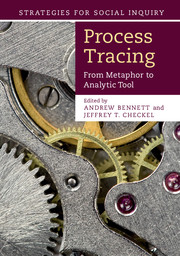Book contents
- Frontmatter
- Contents
- List of figures
- List of tables
- List of contributors
- Preface
- Part I Introduction
- Part II Process tracing in action
- Part III Extensions, controversies, and conclusions
- 8 Improving process tracing
- 9 Practice tracing
- 10 Beyond metaphors
- Appendix Disciplining our conjectures
- References
- Index
10 - Beyond metaphors
Standards, theory, and the “where next” for process tracing
Published online by Cambridge University Press: 05 November 2014
- Frontmatter
- Contents
- List of figures
- List of tables
- List of contributors
- Preface
- Part I Introduction
- Part II Process tracing in action
- Part III Extensions, controversies, and conclusions
- 8 Improving process tracing
- 9 Practice tracing
- 10 Beyond metaphors
- Appendix Disciplining our conjectures
- References
- Index
Summary
In this concluding chapter, we make three arguments. First, there is a strong consensus among this volume’s contributors on the need for a clear understanding of what counts as “an instance of good process tracing.” We document this fact by assessing the fit between the ten criteria advanced in Chapter 1 and their subsequent application by the contributors, arguing that future work utilizing process-tracing techniques must explicitly address all ten of these best practices.
Second, proponents of process tracing need to remember that method is not an end in itself; rather, it is a tool helping us to build and test theory. The development of cumulable social science theory and the theoretical explanation of individual cases are – or, rather, should be – the central goals of process tracing. We advance several design and theory specification suggestions to maximize the likelihood that the process tracing/theory relation is marked by cumulative theoretical progress.
Finally, process tracing is only one way to capture mechanisms in action. Quantitative and experimental methods clearly have roles to play, as do other techniques that can contribute to assessingmechanisms, their scope conditions, and their effects.We make this argument in a final section that highlights three additional challenges for the continuing development and use of process tracing: determining the proper degree of formalization in particular applications of it; raising and implementing standards of transparency; and keeping its application open to the inductive discovery of new theoretical connections, as well as the deductive testing of extant theories and explanations.
- Type
- Chapter
- Information
- Process TracingFrom Metaphor to Analytic Tool, pp. 260 - 275Publisher: Cambridge University PressPrint publication year: 2014
- 3
- Cited by

